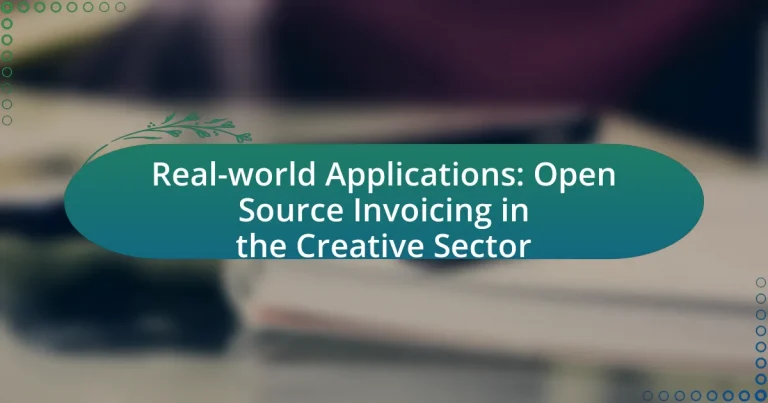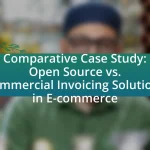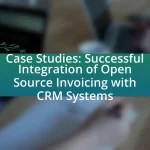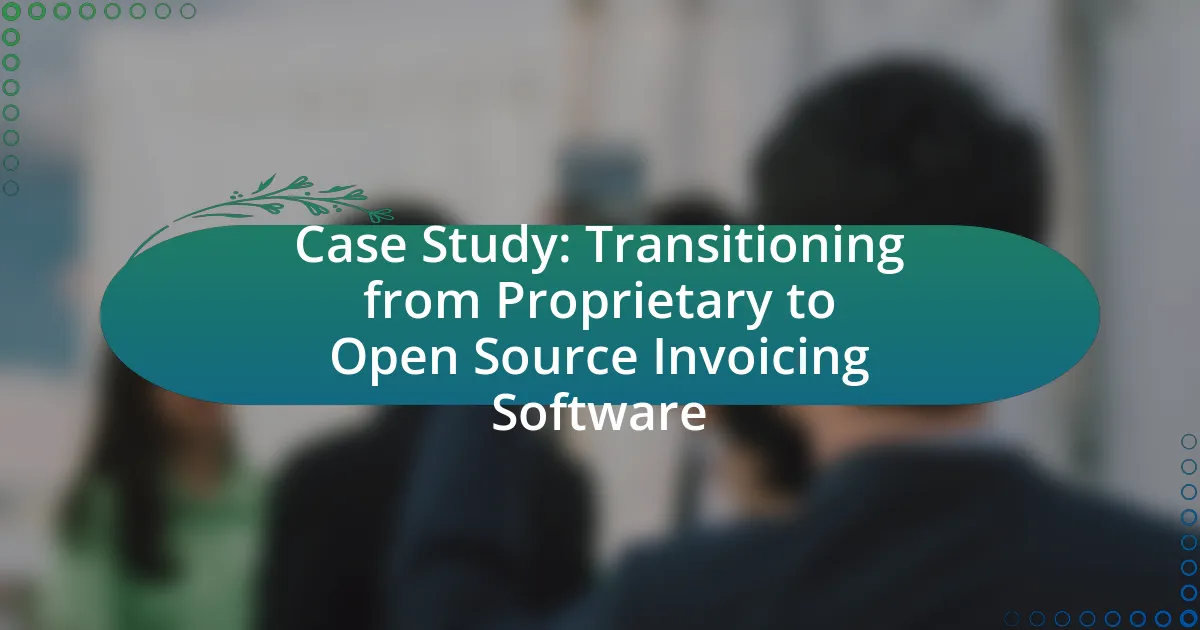Open source invoicing is increasingly utilized in the creative sector, offering customizable, cost-effective solutions that enhance efficiency and financial management for freelancers and agencies. This article explores the real-world applications of open source invoicing, highlighting its benefits, such as tailored invoicing, expense tracking, and automation features that streamline workflows. It also examines the challenges creatives face when using these tools, the importance of community support, and the various platforms available, including Invoice Ninja and Dolibarr. Key considerations for selecting an open source invoicing tool, best practices for usage, and strategies for maximizing benefits are also discussed, providing a comprehensive overview of how open source invoicing can effectively meet the unique needs of creative professionals.
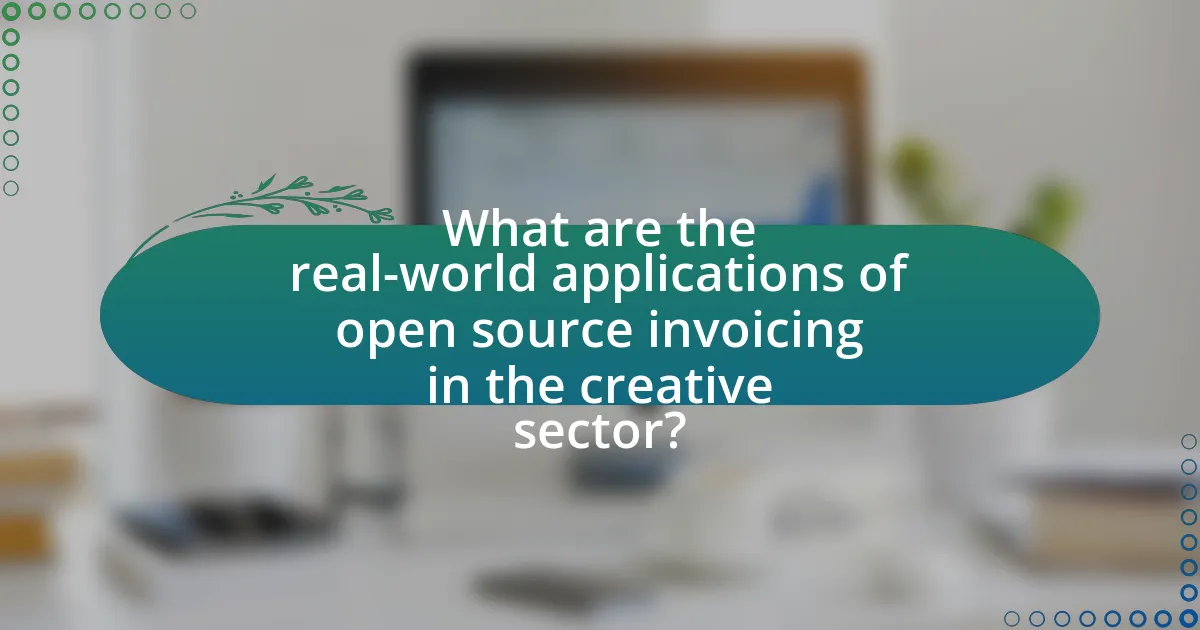
What are the real-world applications of open source invoicing in the creative sector?
Open source invoicing has several real-world applications in the creative sector, primarily enhancing efficiency, customization, and cost-effectiveness. Creative professionals, such as freelancers and agencies, utilize open source invoicing software to create tailored invoices that reflect their brand identity, allowing for greater personalization in client communications. Additionally, these tools often include features like expense tracking and reporting, which help creatives manage their finances more effectively.
For instance, a study by the Freelancers Union found that 77% of freelancers reported that managing invoices and payments was a significant challenge, highlighting the need for efficient invoicing solutions. Open source invoicing platforms, such as Invoice Ninja and Dolibarr, provide these professionals with the ability to automate recurring invoices and integrate with other financial tools, streamlining their workflow and reducing administrative burdens. This not only saves time but also minimizes errors associated with manual invoicing processes.
How does open source invoicing benefit creative professionals?
Open source invoicing benefits creative professionals by providing customizable and cost-effective solutions for managing their billing processes. Creative professionals often face unique invoicing needs that standard software may not address; open source invoicing allows them to modify the software to fit their specific requirements. Additionally, since open source solutions are typically free or low-cost, they reduce overhead expenses, enabling creative professionals to allocate more resources to their projects. According to a survey by the Freelancers Union, 77% of freelancers reported that managing finances is a significant challenge, highlighting the importance of accessible invoicing tools.
What specific features make open source invoicing suitable for creatives?
Open source invoicing is suitable for creatives due to its customization capabilities, cost-effectiveness, and collaborative features. Customization allows creatives to tailor invoices to reflect their brand identity, which is essential for maintaining a professional image. Cost-effectiveness is significant as many open source solutions are free or low-cost, enabling creatives to allocate resources to other areas of their work. Collaborative features facilitate teamwork, allowing multiple users to access and manage invoices, which is particularly beneficial for creative projects involving various stakeholders. These features collectively enhance the invoicing process for creatives, making it more aligned with their unique needs and workflows.
How does open source invoicing enhance financial management for freelancers?
Open source invoicing enhances financial management for freelancers by providing customizable and cost-effective solutions that streamline invoicing processes. Freelancers can tailor open source invoicing software to meet their specific needs, allowing for efficient tracking of income and expenses. This customization leads to improved accuracy in financial reporting, as freelancers can generate invoices that reflect their unique services and pricing structures. Additionally, open source solutions often come with community support and regular updates, ensuring that freelancers have access to the latest features and security enhancements. The flexibility of open source invoicing tools also enables freelancers to integrate them with other financial management systems, further optimizing their workflow and financial oversight.
Why is open source invoicing gaining popularity in the creative sector?
Open source invoicing is gaining popularity in the creative sector due to its cost-effectiveness and customization capabilities. Creative professionals often operate on tight budgets and require flexible solutions that can be tailored to their specific needs. Open source invoicing software allows users to modify the code, enabling them to create unique features that align with their workflows. Additionally, the collaborative nature of open source projects fosters community support and continuous improvement, which is particularly appealing to creatives who value innovation and adaptability in their tools.
What are the cost advantages of using open source invoicing tools?
Open source invoicing tools offer significant cost advantages primarily due to their zero licensing fees. Businesses can utilize these tools without the financial burden associated with proprietary software, which often includes expensive licenses and ongoing subscription costs. Additionally, open source tools allow for customization without incurring extra charges, enabling organizations to tailor the software to their specific needs without hiring expensive developers. According to a study by the Open Source Initiative, companies that adopt open source solutions can save up to 30% on software costs compared to traditional proprietary options. This financial flexibility is particularly beneficial for small to medium-sized enterprises in the creative sector, where budget constraints are common.
How does community support influence the adoption of open source invoicing?
Community support significantly influences the adoption of open source invoicing by providing resources, knowledge sharing, and user engagement. When a strong community exists around an open source invoicing tool, it fosters collaboration and encourages users to contribute to the software’s development, which enhances its functionality and usability. For instance, platforms like GitHub show that projects with active communities receive more contributions and updates, leading to improved software quality. Additionally, community forums and documentation help new users navigate the software, reducing barriers to entry and increasing overall adoption rates. Studies indicate that open source projects with robust community support can see adoption rates increase by over 50% compared to those without such backing, demonstrating the critical role community plays in driving usage and trust in open source invoicing solutions.
What challenges do creatives face when using open source invoicing?
Creatives face several challenges when using open source invoicing, primarily related to usability, support, and integration. Usability issues arise from the often complex interfaces of open source software, which can hinder efficient invoicing processes for users who may not be tech-savvy. Additionally, the lack of dedicated customer support can leave creatives without assistance when encountering technical difficulties, making it harder to resolve issues promptly. Integration with other tools, such as accounting software or project management systems, can also be problematic, as open source solutions may not always offer seamless compatibility, leading to inefficiencies in workflow. These challenges highlight the need for careful consideration when adopting open source invoicing solutions in the creative sector.
What technical skills are required to effectively use open source invoicing software?
To effectively use open source invoicing software, users need technical skills in software installation, basic programming knowledge, and familiarity with database management. Software installation skills are essential for setting up the invoicing system on various operating systems. Basic programming knowledge, particularly in languages like PHP or Python, allows users to customize the software to meet specific needs. Familiarity with database management, such as understanding SQL, is crucial for managing client data and invoice records efficiently. These skills enable users to leverage the full potential of open source invoicing software, ensuring it meets their operational requirements.
How can users overcome common issues with open source invoicing tools?
Users can overcome common issues with open source invoicing tools by actively engaging with community support and utilizing available documentation. Engaging with community forums allows users to seek solutions from experienced peers who have faced similar challenges, while comprehensive documentation provides step-by-step guidance on troubleshooting and feature utilization. For instance, platforms like GitHub often host discussions and issue trackers where users can find resolutions to specific problems, enhancing their understanding and effective use of the tools. Additionally, regular updates and contributions from the community can address bugs and improve functionality, ensuring that users benefit from ongoing enhancements.
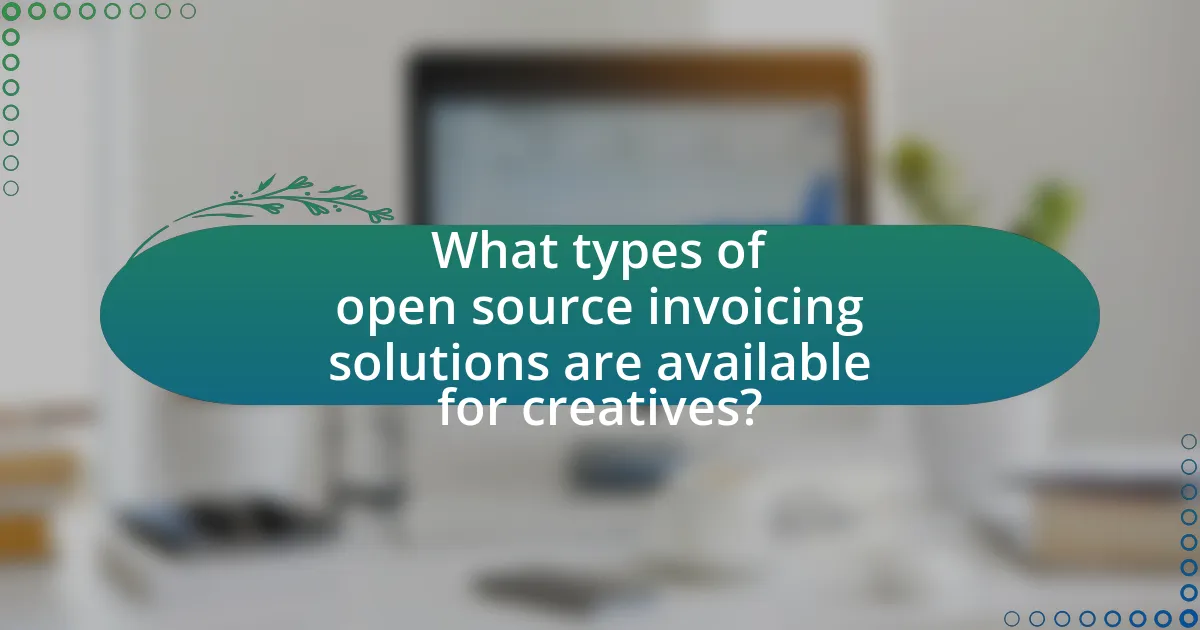
What types of open source invoicing solutions are available for creatives?
Open source invoicing solutions available for creatives include Invoice Ninja, Dolibarr, and Odoo. Invoice Ninja offers customizable invoicing features and supports multiple payment gateways, making it suitable for freelancers and small businesses. Dolibarr provides a comprehensive suite of business management tools, including invoicing, project management, and customer relationship management, which can be tailored to the needs of creative professionals. Odoo is a modular platform that includes invoicing as part of its broader enterprise resource planning capabilities, allowing creatives to manage various aspects of their business in one place. These solutions are widely recognized for their flexibility and adaptability to the unique requirements of the creative sector.
How do different open source invoicing tools compare in features?
Different open source invoicing tools vary significantly in features, catering to diverse user needs. For instance, Invoice Ninja offers extensive customization options, allowing users to create tailored invoices and proposals, while also supporting multiple currencies and payment gateways. In contrast, Dolibarr provides a comprehensive suite that includes invoicing alongside project management and CRM functionalities, making it suitable for businesses seeking an all-in-one solution. Additionally, Odoo stands out with its modular approach, enabling users to select specific features they need, such as inventory management or accounting, which can be integrated with its invoicing capabilities. Each tool’s unique feature set addresses specific requirements, such as ease of use, integration capabilities, and scalability, making the choice dependent on the user’s specific business context and operational needs.
What are the most popular open source invoicing platforms for creatives?
The most popular open source invoicing platforms for creatives include Invoice Ninja, Dolibarr, and Odoo. Invoice Ninja offers a user-friendly interface and features like customizable invoices and payment tracking, making it ideal for freelancers and small businesses. Dolibarr provides a comprehensive suite of business management tools, including invoicing, project management, and CRM functionalities, which are beneficial for creative professionals managing multiple projects. Odoo is known for its modular approach, allowing users to integrate invoicing with other business applications, enhancing workflow efficiency. These platforms are widely recognized in the creative sector for their flexibility and adaptability to various business needs.
How do customization options vary among open source invoicing solutions?
Customization options among open source invoicing solutions vary significantly based on the software’s architecture, community support, and available plugins. For instance, solutions like Invoice Ninja offer extensive customization through a user-friendly interface, allowing users to modify templates and add custom fields easily. In contrast, other platforms like Dolibarr provide a more modular approach, enabling users to select and integrate specific features based on their needs, but may require more technical expertise for deeper customization. The diversity in customization capabilities is often reflected in user forums and documentation, where active communities contribute to the development of plugins and themes, enhancing the flexibility of these solutions.
What are the key considerations when choosing an open source invoicing tool?
When choosing an open source invoicing tool, key considerations include functionality, ease of use, community support, and security features. Functionality ensures the tool meets specific invoicing needs, such as customizable templates and multi-currency support. Ease of use is crucial for quick adoption, especially for users without technical expertise. Community support indicates the availability of resources, updates, and troubleshooting assistance, which is vital for long-term usability. Security features protect sensitive financial data, making it essential to evaluate encryption methods and compliance with regulations. These factors collectively influence the effectiveness and reliability of the invoicing tool in real-world applications within the creative sector.
How important is user interface design in open source invoicing software?
User interface design is crucial in open source invoicing software as it directly impacts user experience and efficiency. A well-designed interface enhances usability, allowing users to navigate the software intuitively, which is essential for freelancers and small businesses in the creative sector who may not have extensive technical expertise. Research indicates that 94% of first impressions are design-related, highlighting the importance of an appealing and functional interface in retaining users and ensuring they can effectively manage their invoicing tasks. Furthermore, studies show that a user-friendly design can reduce the time spent on invoicing by up to 30%, thereby increasing productivity and allowing creative professionals to focus more on their core work.
What role does integration with other tools play in selecting invoicing software?
Integration with other tools is crucial in selecting invoicing software because it enhances workflow efficiency and data accuracy. When invoicing software seamlessly connects with accounting, project management, and payment processing tools, it reduces manual data entry, minimizes errors, and streamlines financial operations. For instance, a study by Software Advice found that 70% of small businesses prefer invoicing solutions that integrate with their existing software to improve productivity and maintain accurate financial records. This integration capability ensures that businesses can manage their finances more effectively, leading to better decision-making and resource allocation.
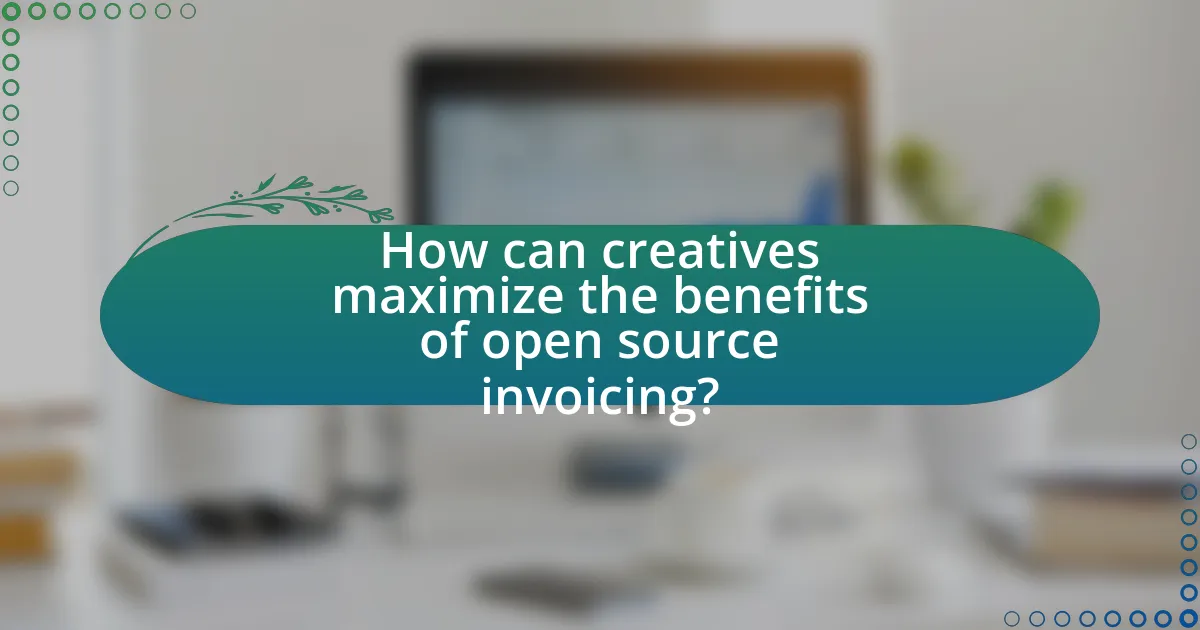
How can creatives maximize the benefits of open source invoicing?
Creatives can maximize the benefits of open source invoicing by customizing the software to fit their specific workflow and branding needs. By leveraging the flexibility of open source platforms, such as Invoice Ninja or Dolibarr, creatives can tailor invoice templates, automate recurring billing, and integrate with other tools they use, enhancing efficiency. Additionally, utilizing community support and resources can lead to improved functionality and troubleshooting, as many open source projects have active user communities that share best practices and plugins. This adaptability and community engagement can significantly streamline invoicing processes, reduce costs, and improve cash flow management for creatives.
What best practices should creatives follow when using open source invoicing?
Creatives should follow several best practices when using open source invoicing to ensure efficiency and compliance. First, they should select a reputable open source invoicing software that is actively maintained and has a strong user community, as this ensures regular updates and support. Second, it is essential to customize invoice templates to reflect branding, which enhances professionalism and recognition. Third, creatives must ensure compliance with local tax regulations by incorporating necessary tax calculations and documentation features within the invoicing software. Additionally, maintaining accurate records of invoices and payments is crucial for financial tracking and reporting. Finally, creatives should regularly back up their data to prevent loss and ensure continuity. These practices help streamline invoicing processes and maintain financial integrity in the creative sector.
How can creatives ensure accurate invoicing and timely payments?
Creatives can ensure accurate invoicing and timely payments by implementing standardized invoicing practices and utilizing invoicing software. Standardized practices include clearly itemizing services, specifying payment terms, and including all necessary details such as due dates and payment methods. Invoicing software automates calculations, reduces errors, and can send reminders for upcoming payments. According to a study by FreshBooks, businesses that use invoicing software report a 30% faster payment rate compared to those that do not. This combination of clear communication and technology enhances the likelihood of receiving timely payments.
What strategies can be employed to streamline the invoicing process?
To streamline the invoicing process, businesses can implement automated invoicing software that reduces manual entry and errors. Automation minimizes the time spent on creating, sending, and tracking invoices, leading to faster payments. According to a study by the Aberdeen Group, companies that automate their invoicing processes can reduce invoice processing costs by up to 80%. Additionally, integrating invoicing software with accounting systems enhances accuracy and provides real-time financial insights, further improving efficiency.
What resources are available for learning about open source invoicing?
Resources for learning about open source invoicing include online platforms such as GitHub, which hosts numerous open source invoicing projects, and documentation sites like Read the Docs that provide guides and tutorials. Additionally, websites like Open Source Invoice offer comprehensive resources and community forums for users to share experiences and solutions. Educational platforms such as Coursera and Udemy also feature courses focused on open source software, including invoicing systems. These resources collectively provide practical knowledge and community support for individuals interested in open source invoicing.
Where can creatives find tutorials and guides on open source invoicing tools?
Creatives can find tutorials and guides on open source invoicing tools on platforms such as GitHub, where many open source projects host documentation and user guides. Additionally, websites like Invoicing Software and Open Source Guides provide comprehensive resources and tutorials specifically tailored for various open source invoicing tools. These platforms often include user-contributed content, forums, and community support, enhancing the learning experience for creatives seeking to implement these tools effectively.
How can community forums assist users in troubleshooting invoicing issues?
Community forums assist users in troubleshooting invoicing issues by providing a platform for shared experiences and solutions. Users can post specific problems they encounter with invoicing software, and other community members can respond with advice, tips, or similar experiences. This collaborative environment often leads to quicker resolutions than traditional customer support, as users can access a wealth of knowledge from diverse perspectives. Additionally, forums may host discussions on common invoicing errors, best practices, and updates on software changes, further enhancing users’ understanding and ability to resolve issues effectively.
What are the common pitfalls to avoid with open source invoicing?
Common pitfalls to avoid with open source invoicing include inadequate documentation, lack of support, and security vulnerabilities. Inadequate documentation can lead to confusion and improper usage, making it difficult for users to fully leverage the software’s capabilities. Lack of support often results in challenges when troubleshooting issues, as open source projects may not have dedicated customer service. Security vulnerabilities are a significant concern, as open source software can be susceptible to attacks if not regularly updated or properly configured. According to a 2021 report by the Open Source Security Foundation, 70% of open source projects have known vulnerabilities, highlighting the importance of maintaining security practices.
How can creatives prevent errors in their invoicing practices?
Creatives can prevent errors in their invoicing practices by implementing standardized invoicing templates and utilizing invoicing software. Standardized templates reduce the likelihood of missing essential information, such as client details, payment terms, and itemized services. Invoicing software often includes features like automated calculations and reminders, which minimize human error and ensure timely follow-ups. According to a study by FreshBooks, 60% of small business owners reported that using invoicing software helped them reduce errors and improve cash flow. This evidence supports the effectiveness of these practices in enhancing accuracy and efficiency in invoicing.
What should users be aware of regarding software updates and maintenance?
Users should be aware that software updates and maintenance are crucial for security, performance, and functionality. Regular updates often include patches for vulnerabilities that could be exploited by malicious actors, as evidenced by the fact that 60% of data breaches are linked to unpatched software. Additionally, maintenance ensures that the software remains compatible with other tools and systems, which is essential in the creative sector where various applications are used in tandem. Users should also note that neglecting updates can lead to decreased performance and potential data loss, highlighting the importance of staying current with software maintenance practices.
